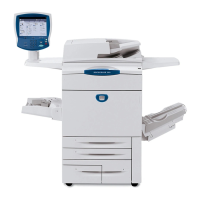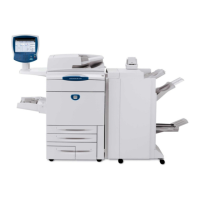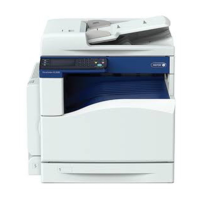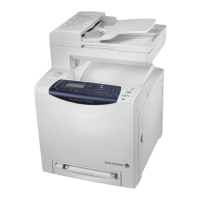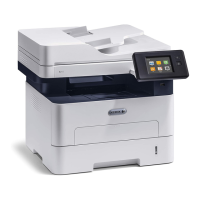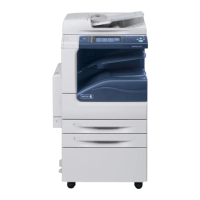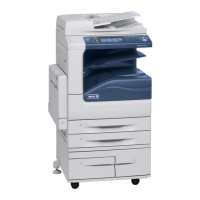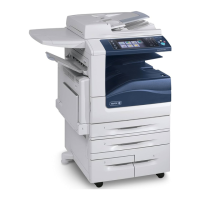1/05
10-99
DocuColor 12/DCCS50
Overview
Principles of Operation
Reissue
Overview
Paper Transportation includes:
• Paper Path Description
• Paper Feeders
• Tray 5
• Paper Registration and Pre-Fuser Transport
• Inverter and Duplex Paper Path
• Print Exit
F
igu
re 1 Motor Drives of the Paper Path
Paper Path Description
The paper feeding process is the same for all four paper trays. The following is a brief descrip-
tion of the copy paper path through the entire machine. For a more detailed explanation, refer
to each subass
embly listed above.
The Tray Lift raises the paper in the Paper Trays to the Feeder Assembly. A solenoid activated
Nudger Roll
feeds paper into the nip of the Feed Roll and the Retard Roll. These two rolls
advance the paper into the vertical transport area which have a series of magnetically clutched
Take Away Rollers (TAR).
The Take Away Rollers advance the paper to t
he Pr
eregistration Rollers. As the paper
advances through the Preregistration Roller, the lead edge of the paper passes a reflective
sensor. The signal from this sensor is compared to the TR0 signal from the IBT by the machine
run control. The machine run control will have the Preregistration Roller run slower or faster so
that the paper will synchronize for proper image transfer at the IBT.
The Registration Rollers are not energized and thei
r
movement is momentarily delayed as the
lead edge of the paper enters the nip. The Registration Sensor sees the lead edge of the paper
and starts a timing delay for energizing the Registration Rollers. While these rollers are not
moving, the paper is still being advanced by the Preregistration Rollers. This forces the lead
edge of the paper onto the non-moving Registration Rolls, and aligns or “de-skews” the paper
square to the Registration Rollers. After de-skewing, the Registration Rolls are energized and
advance the paper to the xerographic marking area of the machine.
The IBT allows all 4 color layers of toner to be transferred to the paper in one pass. The paper
goes bet
ween the I
BT Belt and the second Bias Transfer Roll. There, a combination of pres-
sure and electrostatic charge transfers the toner from the belt to the paper. Exiting the IBT
area,
th
e paper is transported to the Fuser by a Vacuum Belt. A metal guide directs the lead
edge into the nip of the Fuser.
The Fuser has a Heat Roll and Pressure Roll which cam together to create a “Contact Arc” or
pressure
point in the roller nip. The Heat Roll and Pressure Roll apply heat and pressure which
fuses the toner into the paper. The paper leaves the Fuser, passing into the nip of the Fuser
Exit Rollers. If the paper is exiting the machine, it is guided by Exit Inverter Rolls to the Paper
Shelf or the Mailbox/Sorter.
For duplex copying, or for paper that is to be stack
ed in reve
rse order, the paper is diverted by
a solenoid activated Invert Gate before reaching the Exit Inverter Rolls. The Invert Gate directs
the paper into the duplex paper path.
Two pairs of Inverter Rolls drive the paper down int
o the duplex
path. Copy that is to be
reversed stacked is stopped before the trailing edge reaches the second set of Inverter Rolls.
At this position, the paper has passed a strip of Mylar which acts as a gate. The paper reverses
its direction of travel and moves up into the Mylar gate, which guides the paper to the Exit
Invert Roll to leave the machine for reverse stacking.
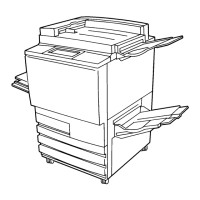
